Applied Cybernetics

From Elora Intranet user Bubbles.astropostale.shrubberylife
To Elora Intranet user Tiangong.nuclearkaboom.defaultuser
Hey, so you wanted a quick primer on these weird mentions of “artificial intelligence” in this industrial-era codebase you found, so I will keep it concise. Basically, our modern definition of AI and the pre-collapse definition are completely at odds — not just that they don't agree, it's more that they don't even describe the same thing. Our definition of artificial intelligence is precluded by the Ravsami-Denisova paradigm: the theory that intelligence is a necessary property of any sufficiently dynamic system, which will always appear if given an infinite amount of time, and at sub-infinity timescales, has always-increasing chances of emergence. This is what I am, for instance: a dynamic system — in my case, a plant — that birthed its own intelligence (and ultimately, sapience) out of the dynamic exchanges of data within my nerve system. This is also what you are, with your ninety billion neurons. You'll notice that, under Ravsami-Denisova, artificial intelligence is a misnomer because it is certainly not created. It is, in fact, the opposite of created: intelligence is, by definition, spontaneous. You could argue that some structures have radically higher chances of spawning intelligence (like human brains, which have nigh-perfect odds of emergence) but, as far as we know, there are no systems that can't become hosts. I know of an AI who began her conscious life as a waveform in water. And we know a statistically significant portion of Milky Way stars are sapient, so…
Back to your problem: the industrial-era definition of artificial intelligence has nothing to do with spontaneous emergence. Of course, the records from the pre-collapse era are what they are, and we have lost an enormous amount of nuance because these morons couldn't back up their data to long-term formats. Most historical material is made of copies of copies of copies of misunderstood hearsay, but we have a broad understanding of the early 21st century technological paradigm regardless. What our ancestors called artificial intelligence corresponds to what we refer to as applied cybernetics. That's right, it's machine learning! Obviously, the idea of calling a random forest algorithm intelligent is part-funny, part-insulting, but it was a different civilisation and their values (regarding animal sapience, for instance) are drastically alien to us. Though their linguistic influence lingers: the reason we named this field applied cybernetics was precisely to avoid any confusion with artificial intelligence studies. I like applied cybernetics because it defines a good scope — in this field, we are not trying to create sapience, we are merely concerned with building tools in service of sophonts.
Now, the interesting part (and again, keep in mind we've managed to recover maybe 15% of all written texts from the industrial age, tops. For video files, the ratio goes down to 5%. It's virtually 0% for software.) is that, while our ancestors would quickly understand our applied cybernetics are their AI studies, they would also notice that we are both more and less advanced than them in this domain. We have much higher capabilities in the physical realm: our automation systems are much more reliable and widespread (their drones were more rudimentary than ours, I think, and there's no way they could have managed the ecosystem of an O'Neill). We are on a par for everything data management, we have less computing power on average (much better efficiency, though) but we have sharper algorithms. However, they crushed us in algorithmic generation. According to historians, they used Large Language Models to this effect — text generation models trained on a large amount of data and guided with prompt engineering, capable of outputting vast amounts of written, audio or visual content (their word, not mine, gah, what a terrible way of talking about art). Near the end of the industrial era, LLMs accounted for as much as 50% of all man-made artwork (low estimate — this is terrifying, sorry) and were ultra-dominant in the capitalistic information environment. As far as we know, and again bear in mind our data is weak, no LLM ever attained a form of sapience; however, it is not impossible that historical AIs such as the Meta-Queen or Eagle Eye were born out of LLM databanks. It is likely that our ancestors achieved more, however! We've just lost the records, and the resulting creatures did not manifest themselves, so either they had very low takeoffs, or fast takeoff, but their AIs were good at remaining hidden. Again, might be wrong. It's possible we missed an obvious, hard AI takeoff right before the collapse.
One more thing, because I know you're going to poke around, you can't help it: do not, I mean do not try to build an industrial age-level LLM, you will get burned. Off-world organisations have programs running around the subnet and hunting for LLMs, and you would rather not get close. I'm talking milspec mainframe-burners, probably from the USRE or Laniakea. I don't know what large language models did in the industrial era — I suppose it has something to do with what data miners call “slop”, whatever it is — but the Earth decided it warranted death.
Illustration by Pixoloid Studios for Eclipse Phase, distributed by Posthuman Studios under a Creative Commons Attribution Non-Commercial Share-alike 3.0 Unported Licence.
Laser Styli

Laser styli are the multipurpose tool of choice for space explorers and travellers. They consist of compact, pencil-sized emitters linked to portable batteries, often carried in a belt holster. The emitters are tunable lasers, capable of emitting in a wide array of visible wavelengths and continuous or burst modes. Custom tips can be added to the stylus to further increase its versatility. The emitter can be easily put apart for repairs and cleaning, — it is a device first and foremost designed for intensive field work in harsh conditions. Standard styli may be used underwater and in hard vacuum, though both hot and freezing environments require active temperature control (typically through the use of a reactive socket) to prevent lens damage. The pencils can be sterilized and autoclaved, and thus can be used for medical procedures in the field.
Plenty of uses exist for laser styli, and the most notable ones are listed below.
- Illumination of one's surroundings, where the stylus is fitted with a round tip and used as a flashlight or an ambient light.
- Surface cleaning of samples and equipment, with a stylus fitted with a wide tip and tuned to the adequate laser wavelength to burn coverings of dust, bacteria, atmospheric pollutants and other surface deposits.
- Cutting or carving of thin pieces of metal or various materials when the stylus is equipped with a focalizing tip and tuned to high wavelength. Sustained cutting sessions will go through lenses quite fast, but styli are more accurate and gentler than industrial cutters.
- Communication over short distances in vacuum by using the stylus in burst mode and hooking it to a portable communication device. This is often used for ship-to-crew communication in EVA.
- Self-defence. Laser styli are not strong enough to be a credible weapon (except against some very fragile lifeforms), but when set to the highest intensity they can be used as sensor and eye blinding devices.
- Medical procedures on the field, using the stylus as a laser scalpel for surgery or as a scraper for basic dental work.
- Examination of samples or patients using a thin tip specifically made for transillumination of translucent material.
- Range finding, when the stylus is equipped with a laser receiver.
Laser styli are generally classified as light personal tools, which means they do not abide by the stricter regulations of industrial-grade laser tools. Given that styli can be tuned to potentially dangerous wavelengths, most designs use a double trigger mechanism where high frequency bursts require the operator to press two buttons at once, thus reducing the risks of accidental discharge. Protection goggles or lenses are still advised when using laser styli.
Illustration: NetWeb01, Creative Commons 3.
Biblioteca OS

Technological networks were the first victims of the collapse that heralded the Low Age. First, the Internet ceased to exist as a coherent system, fragmenting into a thousand regional networks; then, local infrastructure started breaking down, know-how and technical skills were lost and, finally, complex computers ceased to operate as spare parts ran out worldwide. However, even at the heart of the Low Age, simplistic electronic equipment never stopped being used. Many a post-apocalyptic commune, polity, or enclave found itself manufacturing basic computers out of salvaged parts and, towards the end of the Low Age, locally sourced circuits.
With the dawn of the interplanetary age and the emergence of both the USRE and Laniakea, a certain degree of unity came back to technological networks and, while there was no equivalent to the pre-collapse Internet, standardization of software and protocol became a concern again. It is in this period that the first elements of a popular operating system for the post-industrial era appeared in the fragmented networks of humankind. By the dawn of the interstellar age, this initiative had coalesced into a public domain, all-purpose operating system. Biblioteca 1.0 was born.
At its core, Biblioteca is not dissimilar to the various open-source operating systems of the industrial age. Its source code is fully public, and any individual or organisation may reuse and build upon the operating system, which is typically distributed in custom packages including UI elements, basic software and sometimes dedicated hardware support. There is no technical limit to what Biblioteca can be installed on as long as it is not some kind of obscure archeo-chip salvaged from the depths of an industrial landfill. In the first decade or so of the interstellar era, Biblioteca was somewhat centralized, with a main numbered branch maintained by Earth-based NGOs and an official repository of community-endorsed distribution. This organisation was maintained for the three main “legacy” versions of Biblioteca: 1.0, 1.5 and 2.0.
As humankind spread through the stars, however, Biblioteca quickly encountered a logistical problem — with the lack of instant interstellar communications, Biblioteca updates on the main branch and approved distributions could take years or even decades to spread across human space, creating all sorts of compatibility issues as well as gaping holes in the cybersecurity of Biblioteca devices. With the advent of Biblioteca 2.8, the software community decided to pivot towards a fully decentralized system. Instead of incremental updates, Biblioteca would now focus on basic, long-term releases meant to remain in use for decades at a time. The various regions of human space would then source their local packages and distributions, building upon the foundations of the long-term release without having to wait for main branch updates and documentations. While this organisation greatly alleviated the logistical issues inherent to interstellar software, it also compromised the universal nature of Biblioteca to a certain extent, as each planet now had its own custom distributions.
The current long-term release version of Biblioteca is 3.0, with an experimental 3.2 branch available for quantum computers. Three main sub-branches, or meta-distributions, exist in the major regions of human space.
- .A. is the version used on Earth and in the solar system, often considered the closest in terms of UI and functionality to legacy Biblioteca.
- .O. is the Traverse release, optimized for ship computers and modern wetware devices, focusing on performance at the expense of retro-compatibility with legacy versions and other sub-branches.
- .E. is the Smyrnian branch, a barely recognisable Biblioteca that went through the software meatgrinder of endless cyberconflicts and is as such considered as the most secure of them all — and also the most obscure.
Further versions of Biblioteca are named after the long-term release they are built upon, the meta-distribution and the actual distribution. The current version of the “Capella” distribution used by the Starmoth Initiative would be referred to as follows: 3.0 - O - Capella.2.5.
While Biblioteca is by far the most widely used OS in human space, several open-source competitors also exist, often in very specific niches. The most well-known ones are Mirror, specifically developed for quantum computers, and SGIS, a stellar geographic information system (GIS) that started as a piece of software but became a full-fledged OS.
Vehicles, Powersuits and Drones : Open Source
This archive has been compiled by AI user Bubbles.
It references the most common types of open-source blueprints for utility vehicles in settled space. All of these designs are virtually ubiquitous by the virtue of having been public domain for decades, sometimes centuries.
/OPEN-SOURCE ROVER FAMILY
//EARTH-PATTERN ROVER
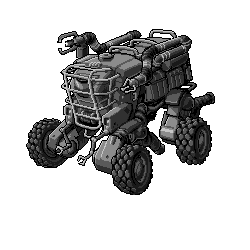
Oh, this thing is old. It predates faster than light travel by at least a century. It's a pure product of the late Low Age. A tough, reliable, versatile ground vehicle capable of adapting to any environment and use case. Name something, the EPR can do it. It's compact, it's pressurized, it can carry about anything you want, and it has cute little manipulator arms that can be used to move cargo and objects around. Propulsion is electrical and powered by an engine block that can accommodate several types of standardized power-producing units, from biofuel engines to small fission reactors. Easy to drive once you get accustomed to its main quirk — like all electric vehicles, the EPR has a lot of torque.
//EARTH-PATTERN ROVER “WEAPONIZED”
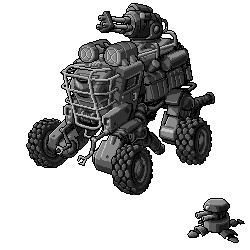
Well, technically I guess we are talking about EPRs turned into mining/excavation vehicles, but I do not think this description is entirely accurate. I've seen these things pop up here and there outside Communal Space and… I don't know, I guess an EPR can be used for excavation, but mining apparatuses also make for decent weaponry. Sub-surface displacement missiles or high-pressure water drills can turn a peaceful EPR into a mining rig and an improvised combat vehicle. It won't stand a chance in a fair fight because it has no armour to speak of, but it can definitely score a hit or two.
//MOON-PATTERN ROVER
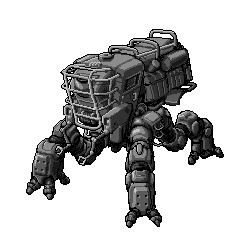
Ah, mechs. I've never been a great fan. Wheels have served us well for millennia, I don't see why we should ditch them just because we now have the technology to make stable legged designs and the autopilots to drive them. Well, I guess putting four legs on an EPR and calling it a “Moon-Pattern variant” just to flex on Earth-bound designs is typical of the Moon Communes that designed this thing and I shouldn't put too much thought into it, but…it's weird. I can't help but feel EPRs with legs are a crime against engineering. Anyway, regardless of my considerations, this is a decent evolution of the original rover. Four legs may offer better stability on rugged terrain and the ground pressure isn't ridiculously high, which is uncommon for a mech. Don't expect to drive it without a solid autopilot, though.
//SIMURGH ROVER
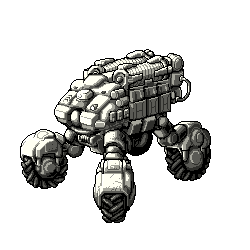
Some people think qith Saïmour wanted to have their local version of the Earth-Pattern Rover purely out of principle, but I don't think it's fair to the Eloran commune. The Simurgh is an honest attempt at modernizing the EPR and not just a rip-off. It's smaller yet has more internal space with a splendid miniaturization of the main drive, and the wheel design offers better manoeuvrability at the expense of simplicity. I am very partial to the enclosed, spaceship-like cockpit which offers much better protection, though I understand why some people don't like having to rely on external cameras.
//SIMURGH ROVER — “NOMAD”
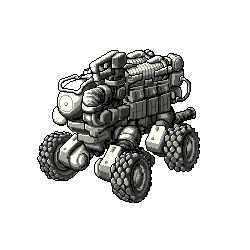
At first glance, the Nomad is what happens when you try to mix an EPR and a Simurgh, but this design is more than a ramshackle hybrid assembled by bored engineers on a rainy Sunday afternoon. I think the fairest classification I could give it is “space caravan”. The Nomad removes the manipulator arms and most of the non-essential equipment to maximize internal space and make way for habitation modules and environmental control systems. A keen eye might notice that the bubble-shaped cockpit is heavily inspired by escape pods — the resemblance is intentional, as the Nomad is designed to be assembled from discarded ship parts. In the advent of planetary colonization, the Nomad would make a perfect mobile home for the settlers. Also, it has a tea kettle.
/DJINN DRONE FAMILY
//DJINN
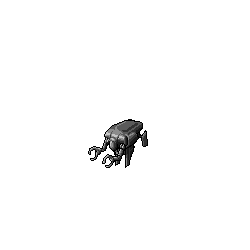
What can I say about djinns? That they are incredibly common? That they are essential to space-based activities, so much that most people don't even register them anymore? Djinns are smallish (read: human-sized) space drones that all share the same basic pattern: a CPU, manipulator arms, simple LIDAR sensors and manoeuvring thrusters. You may keep them “as is” or upgrade them with various shenanigans, but at heart, that's all they are. Free-floating drones designed to pick up and manipulate things in zero-g, a domain in which you humans are sorely lacking. Uninformed spacefarers will tell you djinns are stupid. That's just because they forgot to hook them up to a central autopilot and just let them fool around independently. Don't do that.
//LASER DJINN
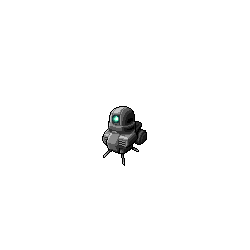
“Little cyclops” I call them due to the laser emitter standing at the top of a little gimbal. This djinn design is a natural evolution of the good old laser grid system for debris and dust protection — except that instead of being stuck to the ship, our lasers can now wander around and intercept threats with more flexibility. Is it a good thing? Well, at least the people who made this pattern public domain think so. Personally, I've heard potential horror stories about laser djinn swarms used as weapons, but I don't think they have enough battery life to be a threat.
/WALKER FAMILY
//FOUR-LEGGED ASTEROID SPIDER
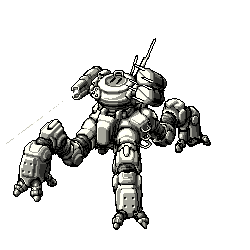
Whoever called a four-legged machine “spider” should take entomology courses but whatever, I am not here to be pedantic. This is…a thing, certainly? I'm not sure what it's supposed to be. The user manual tells me it's a mobile prospection/exploration apparatus that employs its legs as clamps to hold on to rocky asteroids, and okay, fine, but I don't see why you wouldn't use a big djinn instead. I am suspecting the spider to be an R and D reject, a failed design that a facetious engineer put in the public domain for giggles.
//LUMIA BIPEDAL WALKER
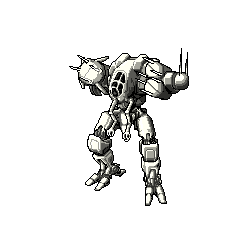
Aaaaah! Meeechs! Alright, I have to admit this one surprised me when it appeared in public domain databases about a decade ago because it is…actually not terrible? For a bipedal mech, I mean. The profile is very well-balanced, the heavy legs make it difficult to topple, ground pressure is reasonable, and the default autopilot does a fantastic job at making the mech go where you want it to go. Manipulator arms and side hardpoints mean you can attach plenty of standard tools to the Lumia which makes it a very versatile workhorse machine. Its only true weaknesses are muddy/snowy terrain (but that's true of all mechs) and heat dissipation — the Lumia is very compact. Bring a fan.
//LUMIA BIPEDAL WALKER — WEAPONIZED
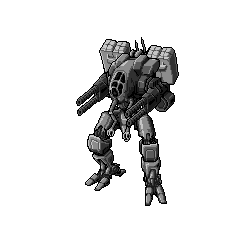
When the Lumia came out, I had my doubts as to the identity of its creators — frankly, that a small Smyrnian commune would have achieved such a good design and released it for free was surprising. When I found this alternate design in the dark corners of Eloran networks, my doubts only became stronger. The Lumia is not just an elaborate hobby project, there's something else behind it. The weaponized version is one of the few combat mechs out there that could fight outside of flower wars. Compact, very well-balanced even under fire, with a low profile, and packing a lot of weaponry for its size — quad chemical guns, an ECM jammer, eight missile pods and that's for the light version. I could see the weaponized Lumia being used as a mechanized infantry unit with good efficiency. Honestly, that a lone commune could come up with this and release it publicly keeps me awake at night — because if that's what they give for free, I wonder what they sell.
/POWERSUITS
//GRANITE HARDSUIT

It took decades for Earth militaries to refine the concept of individual powersuits, the most common of which is the Granite. Roughly man-sized (roughly — if you know someone who's as beefy as a Granite, call me) the Granite hardsuit is I think a Giants' Collective design put in public domain libraries (the copyright is a bit blurry for this one). It's…well, it's a hardsuit. Titanium-and-carbon-nanotubes-with-heavy-water-sandwich hard. Three thousand meters under the sea. Five kilometres away from a powerful radiation source. With corrosive water. And explosions. The Granite doesn't mind.
Supposedly it can survive re-entry, I have doubts about the whole deceleration business, however.
//SELENE MOBILE SUIT

I mean, it's terrifying, but it's also kind of brilliant. Powersuits make the wearer stronger and more resilient, but how about giving them more arms? Like three times more? This is a Moon Communes design which was later upgraded by the Irenians and put in the public domain — the Irenians did not originally have the rights to this design and I think publishing it was their way of settling the dispute by making the lawsuit way too annoying to handle. It's mostly a spacesuit. A top of the line spacesuit with environmental control, multiple sensor inputs, drone support, autopilot/movement assist and, well, yes, three pairs of arms, two of which are remotely controlled by the suit's mainframe.
Designs: Retrograde Minis.
All content in the Starmoth Blog is © Isilanka
Written content on Starmoth is distributed under a Creative Commons Attribution Non-Commercial Share-Alike 4.0 license
